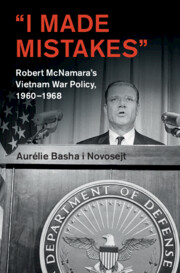Book contents
- “I Made Mistakes”
- Cambridge Studies in US Foreign Relations
- “I Made Mistakes”
- Copyright page
- Dedication
- Contents
- Figures
- Acknowledgments
- Abbreviations
- Introduction
- 1 The History of the Office of the Secretary of Defense, 1947–1961
- 2 Civilian Control
- 3 Continuity and Change
- 4 Taking Charge of Vietnam Policy
- 5 When Military Problems Become Economic Problems
- 6 The Fall of 1963
- 7 McNamara’s Transition into the Johnson Administration
- 8 Decisions, Indecisions, Visions and Revisions
- 9 McNamara in Crisis, 1966–1968
- Conclusion
- Appendix: Cast of Characters
- Endnotes
- Bibliography
- Index
5 - When Military Problems Become Economic Problems
Published online by Cambridge University Press: 26 February 2019
- “I Made Mistakes”
- Cambridge Studies in US Foreign Relations
- “I Made Mistakes”
- Copyright page
- Dedication
- Contents
- Figures
- Acknowledgments
- Abbreviations
- Introduction
- 1 The History of the Office of the Secretary of Defense, 1947–1961
- 2 Civilian Control
- 3 Continuity and Change
- 4 Taking Charge of Vietnam Policy
- 5 When Military Problems Become Economic Problems
- 6 The Fall of 1963
- 7 McNamara’s Transition into the Johnson Administration
- 8 Decisions, Indecisions, Visions and Revisions
- 9 McNamara in Crisis, 1966–1968
- Conclusion
- Appendix: Cast of Characters
- Endnotes
- Bibliography
- Index
Summary
McNamara’s appreciation of the military problems in Vietnam was intimately connected to economic developments in Washington. A continued balance of payments deficit and an unsettled domestic economic picture heightened the administration’s sense of vulnerability. The Senate Foreign Relations Committee (SFRC) exerted new pressure on the Military Assistance Program (MAP) that funded operations in Vietnam. With Dillon, McNamara worked on a Cabinet Committee on the Balance of Payments that recommended significant troop redeployments around the world. The JCS and State Department stymied their efforts. In this context, McNamara met with the famed economist John Kenneth Galbraith, who was especially critical of the growing commitment in Vietnam. McNamara chose a counterinsurgency strategy in Vietnam because it was cheaper as it relied on local forces. As Galbraith and others recommended, McNamara moved to downgrade the relative importance of South Vietnam to US security and to emphasize that the conflict was an internal insurgency. He used the pressures on the MAP to accelerate the phaseout of the US presence in South Vietnam.
Keywords
- Type
- Chapter
- Information
- ‘I Made Mistakes’Robert McNamara's Vietnam War Policy, 1960–1968, pp. 93 - 119Publisher: Cambridge University PressPrint publication year: 2019



